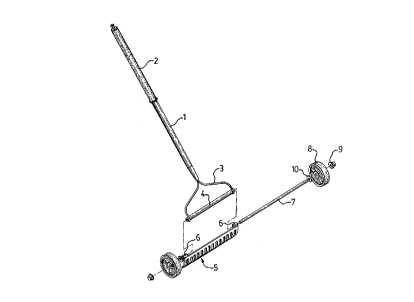Some of the information on this Web page has been provided by external sources. The Government of Canada is not responsible for the accuracy, reliability or currency of the information supplied by external sources. Users wishing to rely upon this information should consult directly with the source of the information. Content provided by external sources is not subject to official languages, privacy and accessibility requirements.
Any discrepancies in the text and image of the Claims and Abstract are due to differing posting times. Text of the Claims and Abstract are posted:
| (12) Patent: | (11) CA 2063128 |
|---|---|
| (54) English Title: | RAKE WITH WHEELS AND SWINGING COMB |
| (54) French Title: | RATEAU A ROULETTES ET A PEIGNE BASCULANT |
| Status: | Deemed expired |
| (51) International Patent Classification (IPC): |
|
|---|---|
| (72) Inventors : |
|
| (73) Owners : |
|
| (71) Applicants : | |
| (74) Agent: | BORDEN LADNER GERVAIS LLP |
| (74) Associate agent: | |
| (45) Issued: | 1999-01-19 |
| (22) Filed Date: | 1992-03-18 |
| (41) Open to Public Inspection: | 1992-11-10 |
| Examination requested: | 1992-03-18 |
| Availability of licence: | N/A |
| (25) Language of filing: | English |
| Patent Cooperation Treaty (PCT): | No |
|---|
| (30) Application Priority Data: | ||||||
|---|---|---|---|---|---|---|
|
A rake is described, having wheels mounted rotatably
thereto which enable the rake to be moved easily from place to
place without lifting the rake from the ground. When the rake
is pulled towards the user, the comb is locked such that its
teeth are in the conventional operative position, i.e. pointing
downwardly, but when the rake is pushed away, the comb rotates
out of the way to permit the rake to be pushed easily, even over
piles of debris just raked.
L'invention porte sur un râteau auquel sont montées des roues, grâce auxquelles il est possible de déplacer le râteau sans le soulever du sol. Lorsque le râteau est tiré, la traverse se bloque de façon à placer les dents dans leur position opérationnelle classique, c'est-à-dire pointant vers le bas, mais lorsque le râteau est poussé, la traverse se rétracte, ce qui permet de pousser le râteau sans difficulté, même par-dessus des tas de débris tout juste râtelés.
Note: Claims are shown in the official language in which they were submitted.
Note: Descriptions are shown in the official language in which they were submitted.

For a clearer understanding of the status of the application/patent presented on this page, the site Disclaimer , as well as the definitions for Patent , Administrative Status , Maintenance Fee and Payment History should be consulted.
| Title | Date |
|---|---|
| Forecasted Issue Date | 1999-01-19 |
| (22) Filed | 1992-03-18 |
| Examination Requested | 1992-03-18 |
| (41) Open to Public Inspection | 1992-11-10 |
| (45) Issued | 1999-01-19 |
| Deemed Expired | 2002-03-18 |
There is no abandonment history.
| Fee Type | Anniversary Year | Due Date | Amount Paid | Paid Date |
|---|---|---|---|---|
| Request for Examination | $200.00 | 1992-03-18 | ||
| Application Fee | $0.00 | 1992-03-18 | ||
| Maintenance Fee - Application - New Act | 2 | 1994-03-18 | $50.00 | 1994-03-14 |
| Maintenance Fee - Application - New Act | 3 | 1995-03-20 | $50.00 | 1995-02-01 |
| Maintenance Fee - Application - New Act | 4 | 1996-03-18 | $50.00 | 1996-02-15 |
| Maintenance Fee - Application - New Act | 5 | 1997-03-18 | $75.00 | 1997-05-23 |
| Maintenance Fee - Application - New Act | 6 | 1998-03-18 | $75.00 | 1998-02-26 |
| Final Fee | $150.00 | 1998-10-02 | ||
| Maintenance Fee - Patent - New Act | 7 | 1999-03-18 | $75.00 | 1999-01-21 |
| Maintenance Fee - Patent - New Act | 8 | 2000-03-20 | $75.00 | 2000-03-06 |
Note: Records showing the ownership history in alphabetical order.
| Current Owners on Record |
|---|
| QUESNELLE, STELLA M. |
| QUESNELLE, ALBERT A. |
| Past Owners on Record |
|---|
| None |